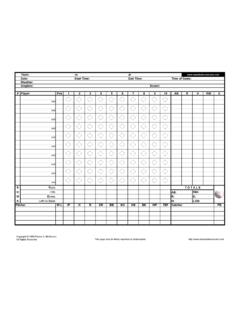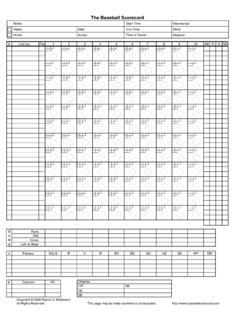Transcription of The Baseball Scorecard Tutorial
1 The Baseball ScorecardPatrick A. McGovernCopyright 1999-2000 by Patrick A. McGovern. All Rights ScoreWhat's happened?What do you say when somebody asks you this question? If you're like most people, you probably repeatthe information that's available on the scoreboard along with a couple of the more memorable score makes it possible to give an accurate, concise run down of the game's events. Peopleseem to appreciate this. I've met a lot of new people this way, which adds to the enjoyment of a Ball!I know that umpires are supposed to just say "play", but I couldn't think of anything else to get thingsstarted. Follow the links below. Hopefully, they will help you learn to score a Baseball ScorecardGetting a ScorecardIf you go to a Baseball game, you'll notice a vendor selling programs. Where I go to games the officialprogram sells for about $ Outside some ballparks you can find a vendor who is selling an unofficialprogram for about $ Programs are great sources of information about the teams and players that areplaying that day.
2 They also contain a Scorecard . If you don't want to use the Scorecard from the ballpark,you can buy a book of them at a sporting goods store. You may also create one yourself. It's not you prefer, you may download and use one of the simple scorecards that I at the ScorecardNow that you've got a Scorecard , take a look at it. There will be areas for different kinds of data such asgame day information, batter performance, inning totals, and pitcher performance. Most scorecards willalso contain an area to record a summary of the players' game performance afterwards. I didn't include asummary area on one of the scorecards I created, but creating a card of your own which contains oneshouldn't be that difficult. The summary area should contain the following information for each batter: at-bats, runs, hits, runs batted in, and errors. Once you have this information tallied, you'll be able tocompute all sorts of statistics if you StartedGame DataOnce you've familiarized yourself with the Scorecard layout, it is time to start filling it in.
3 Normally at thetop you'll find places to log information such as team names, date, and time. Some scorecards alsocontain spaces for location, temperature, weather, team win-loss records, and several other cards will even provide space for umpire and coach names. Fill in as much as you want, but besure to fill in the team names, date, and time. If you don't, you won't know what game you were scoringwhen you find the Scorecard in the bottom of a drawer a few months DataNext, find where you'll be entering player data. This will be a grid with inning numbers and otherdesignations running across the top and spaces for the players' names, numbers and positions down theside. Fill these in when the batting order is announced. Before entering the player positions, you shouldbe aware of one standard way of recording them. Instead of alphabetic abbreviations, most people assignnumbers to the positions. The standard position numbers are shown - Pitcher; 2 - Catcher; 3 - 1st Base; 4 - 2nd Base; 5 - 3rd Base; 6 - Shortstop; 7 - Left Field; 8 - Center Field; 9 -Right FieldA designated-hitter is represented by "DH".
4 These numbers are easy to remember if you start with the pitcher and then work your way around thebases. The only hitch is the shortstop. You would think that the numbers for shortstop and third baseshould be reversed. One explanation that I've read was that the shortstop was not originally consideredpart of the infield. It was originally part of the outfield as a "short fielder." I don't know if this is true or not,but it does explain the number , you'll notice an area where you can register the statistical totals. Some of these, such as runs andhits, are totaled after each half-inning. Others, such as player and team totals, are tallied after the gamehas been played. We'll discuss this section ShorthandScorekeeping is accomplished by a sort of "shorthand," which is basically a combination of positionnumbers and abbreviations. Refer to the Scoring Abbreviation page to see some common numbers andabbreviations used throughout a Up!
5 Let's see what we need to do as each player has his turn at bat. We'll confine ourselves to the top of you've familiarized yourself with the position numbers, you'll see that the center fielder, secondbaseman, catcher, and right fielder are the first batters singles to center field. A lot of pre-printed scorecards will have a diamond representing the field inthe middle of each box. To mark Smith's single, we'll darken the line from home to first and place a 1 Bnext to it. I also like to draw a line to show where he hit the 's up next and he strikes out swinging. A "K" is placed in his box to indicate that he struck out. If itwas a called strike three, a "Kc" or a backwards "K" would be placed in the box. A circled "1" is alsoplaced in the box to indicate that it was out number is batting next, but while he is batting Smith manages to steal second. The line from first to secondshould be darkened and an "SB" along with a number to indicate who was at bat is written to indicate thatSmith stole second during Henry's plate appearance.
6 I like to use the player's jersey number for this. Itmakes it easier for me to keep track of things. Other people use the player's position number. So, I couldhave just as easily written "SB2" instead of "SB17".Henry manages to draw a walk. The line from first to second is darkened and either a "BB" or "W" iswritten to indicate the walk. I prefer to use BB for "Base on Balls."Jones is now at bat and hits it to the short stop who tosses it to the second baseman who tags the bag toget Henry out. The second baseman then throws to first to get Jones out. A classic 6-4-3 double play,which is what is written in Jones' box. Of course, both outs must be recorded. So a line is drawn halfwaybetween first and second in Henry's box and is marked with a '33' to indicate that Jones was the batter. Acircled '2' is also entered to indicate that Henry was the second Jones' box a 6-4-3 is written along with a 'DP' for the double play and a circled '3' to indicate the thirdout.
7 A 'DP' could also have been entered in Henry's box to indicate that he was caught up in the doubleplay as well. One other method is to draw a line connecting the two '6-4-3' above is an example of how all players who were involved in putting the runner out are this is the third out, a slash is drawn across the lower right-hand corner of Jones' box to indicate theend of the inning. This is what the Scorecard should look like after the first a SwingHopefully, the above examples will give you an idea about how scorekeeping is done. Give it a try nexttime you go to out to the ballgame. Also, don't be afraid to experiment. What works best for others maynot be best for you. I am always open to suggestion and would appreciate any that are offered. So, if youcome up with something that works well, I would be glad to hear about WAYS TO GET ON BASE Single Double Triple Home Run Home Run Base on BallsHit By Pitch Fielder s Error Wild Pitch Passed Ball Catcher s Choice (3rd Strike)(3rd Strike)InterferenceGround Rule DoubleWAYS A BATTER MAKES AN OUT Strikeout Strikeout Strikeout Strikeout Fly Out Foul Out (Swinging) (Called) (Swinging) (Called) (to Left Field) (to Right Field) Line Out UnassistedGround Out Forced Out or Tag Infield Fly(to 3rd Base) Put Out (3rd throws to 1st) RuleWAYS A RUNNER MAKES AN OUTF orce Out or Caught Stealing Run DownTag (3rd to 2nd) (Pitcher to 3rd) (Catcher to 2nd to 1st to 2nd)SubstitutionsLater in the 've never seen a game where at least one substitution was not made.
8 There are many reasons to replacea starter: pitchers get tired, batters aren't hitting, players get injured, someone's ejected, or the managermakes a strategic move. Whatever the reason, sooner or later you're going to have to mark a substitutionon your , how do you do this? It depends on the batter substitutions, I draw a line between the last scorebox of the previous batter and the firstscorebox of the new the new batter is a pinch hitter, place "PH" in the position box. If he is taking a position in the field, usethe normal position numbers. If players are moved around in the field, you'll want to show that on yourscorecard. Usually, I make a note by the player's name indicating the a substitution is made for the pitcher, place a line under the score box of the last batter theprevious pitcher the GameBack in the DugoutNow that the game is over, you can tabulate all the data you've compiled. If you haven't been keeping upwith it during the game, now is the time to add up the statistics for each inning: runs, hits, errors, passedballs, and men left on base.
9 You can also add up the data for each pitcher: innings pitched, batters faced,strikeouts, walks, hits, runs, earned runs, wild pitches, batters hit, and balks. There may be other statisticsthat you can fill in on your card, but these are the fields on the Scorecard that I created. Professionallyprinted scorecards may contain several fields to tally a batter's performance: at-bats, runs, hits, singles,doubles, triples, home runs, runs batted in and others. It's up to you to decide how much you want to you want to learn the formulas for calculating batting average, earned-run average, on-basepercentage, or several other stats, check out my statistics official scorekeeper must prove the official box score, which is what becomes part of the officialrecord. The formula is very simple and must be applied to each teams , total the number of runs, men left on base and opponents' putouts for one team. Next, total thenumber of at-bats, walks, sacrifices, batters hit by pitcher and awards of first base due to interference forthe same team.
10 If these two totals are equal than this team's box score is "proven." Repeat the processfor the other 've never tried to prove a box score, but I thought others might find it StatisticsMany people like to calculate player statistics. I'm not one of them, but I decided to add a page about itanyway. I will use the following symbols in calculating the statistics:(+) addition, (-) subtraction, (*) multiplication, and (/) StatisticsBase-on-balls Percentage(total walks) / (plate appearances)Batting Average(total hits) / (official at-bats)At-bats do not include walks, sacrifice flies, sacrifice bunts, obstruction calls, catcher's interference, orbeing hit by a pitch. If a player makes it safely on base due to an error, it is an at-bat, but not a Run Ratio(at-bats) / (home runs)On-base Percentage(hits + walks + hits by pitch) / (at-bats + walks + hits by pitch + sacrifice flies)Slugging Average(total bases) / (at-bats)The number of total bases only includes those obtained from hits.




